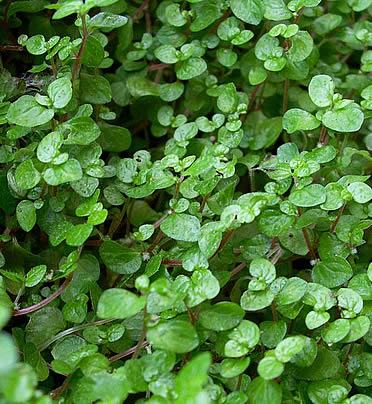Baby’s Tears (Soleirolia soleirolii) is a herbaceous, evergreen, branched, and creeping plant with ornamental foliage, native to Corsica and Sardinia, Italy. The scientific name comes from Joseph François Soleirol (1796-1863), who collected the plant in Corsica in the early 19th century. It features prostrate, fragile, branched, and pubescent stems that produce roots as soon as they touch the ground. It grows indefinitely horizontally, covering the ground with a dense green carpet.
Its leaves are tiny, abundant, rounded, entire, shiny, and have short petioles. The small white flowers appear in summer in the leaf axils and have little ornamental significance. The fruit is of the achene type. There are cultivars of the plant with different shades of green, such as the ‘Variegata’ with variegated white leaves, and the ‘Aurea’ with a lime-green tone.
](https://shrubz.us/wp-content/uploads/2015/09/Soleirolia_soleirolii.jpg)
Its fine texture is of great interest, and many say it resembles curly hair, creating a contrast with lawns or other ground covers. It works well as a mass planting, border, or background for other species in beds, pots, or containers, particularly in hanging baskets where the plant’s foliage cascades like a green waterfall.
It is also commonly used around ponds, filling spaces between rocks, softening and adding a natural feel to the area. As it thrives in shade and humidity, it’s suitable for closed terrarium compositions. Considered edible with a spicy flavor, it can be used as a substitute for watercress in salads and sandwiches.
It should be cultivated in indirect light, in fertile, well-draining soil enriched with organic matter, and regularly irrigated to maintain moisture without waterlogging. Reduce watering in winter and supplement summer watering with leaf sprays. It does not tolerate direct sunlight, especially during the hottest hours of the day, as it would inevitably scorch its delicate leaves. It is also not resistant to drought or frost.
In temperate climates, without protection, Baby’s Tears lose their leaves in the cold winter, becoming deciduous, but can regrow in spring. Ideally, in these conditions, bring it indoors or to protected environments like humid greenhouses, especially when frost is imminent. It easily propagates through division of rooted stems or by cuttings. Due to its creeping nature, it quickly roots at nodes, facilitating propagation.


